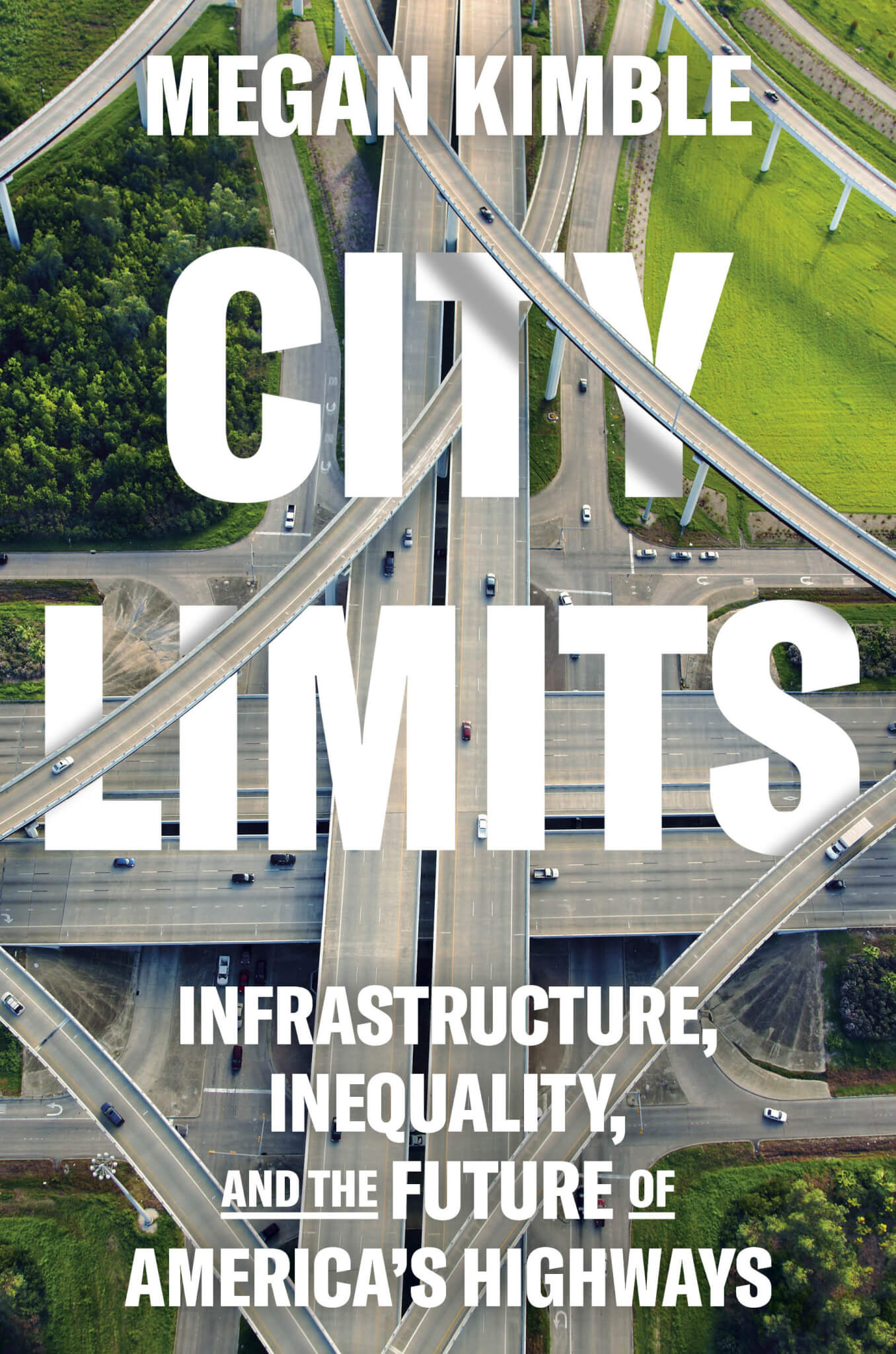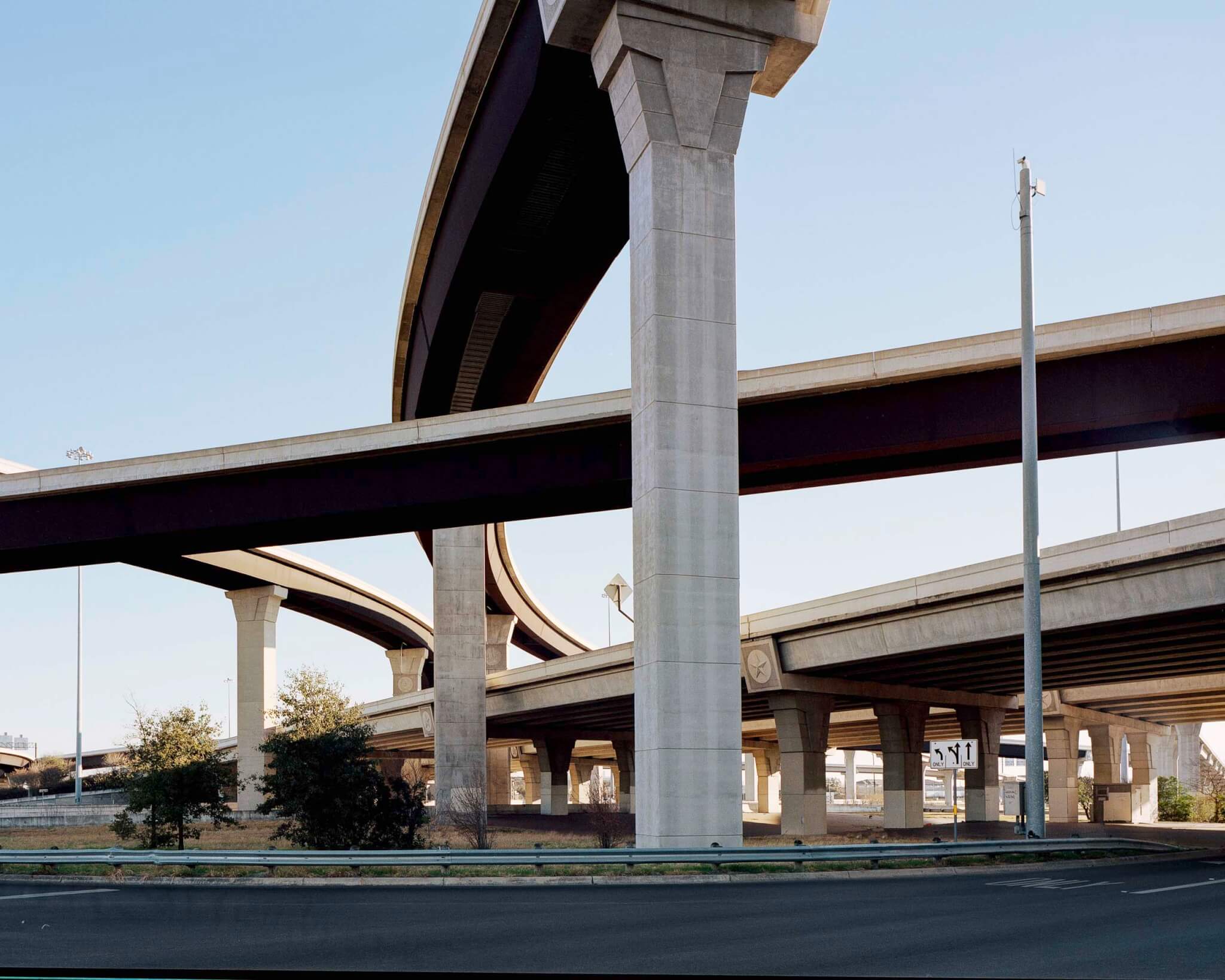City Limits: Infrastructure, Inequality, and The Future of America’s Highways by Megan Kimble | Penguin Random House | $30
It was pouring rain the day I moved to Chicago, finishing a grueling 17-hour drive to become a new resident of a sprawling metropolis. Entering the city limits from I-90, a freeway that is somehow packed with traffic while also serving as a de facto race course for impatient drivers, I was greeted by massive digital billboards that I would later learn broadcast the Illinois Department of Transportation’s (IDOT) public service announcements. These billboards sometimes cheekily read, “No texting, no speeding, no ketchup” (a Chicago joke) or, during Halloween season, “Speed demon, I cast thee out; drive the limit.” But on this day, the billboard was programmed to tell drivers precisely how many car wrecks had occurred in the county that year.
I don’t remember the precise count—certainly in the thousands—but I do recall being astonished. Not by the number, but that the department responsible for freeways would so candidly demonstrate how deadly it is to use the product it builds. Since that rainy day in 2012, I-90 and myriad other freeways running through the city have continued to expand—adding a few lanes here, a flyover there, and general confusion: Why do we continue expanding infrastructure that increases the likelihood of injury or death, especially when we know it won’t decrease commute times?

Megan Kimble tackles this and similar tensions in her new book, City Limits: Infrastructure, Inequality, and the Future of America’s Highways. In its 400-ish pages, the book is a fiery critique of urban interstate developments. Something so ubiquitous and widely accepted as freeways requires a nuanced exploration of the infrastructure’s counterintuitiveness. For anyone whose interests or political views might make them believe “freeways are bad,” much of those supporting arguments could be condensed into an email: Freeways are dangerous for drivers; they’ve divided our cities in ways that reinforce segregation; they spew toxic materials into the air we breathe and produce life-altering noise. But instead of relitigating such realities, Kimble brings together tender, first-person accounts of community organizing, discovery, and tragedy interspersed with rich research into how our 85-mile-per-hour world came to be.
City Limits focuses primarily on three Texas cities and their traffic behemoths: Houston’s I-45, Austin’s I-35, and Dallas’s I-345. Each urban freeway has its challenges to be addressed by the Texas Department of Transportation (TxDOT). According to TxDOT, Houston’s population growth and traffic concerns—that I-45 “was the most dangerous stretch of highway in the state”—required an enormous and offensive 50 percent expansion. Austin’s I-35 also needed to expand to a 20-lane road, including frontage roads, that would displace more than 100 homes and businesses to manage daily traffic congestion. I-345, which connects South Dallas with northern neighborhoods, was one of the only freeways without a planned rebuild noted in the city’s 2011 master plan. While Austin and Houston activists sought alternative solutions to expansion, activists in Dallas hoped to have the stretch removed and turned into a boulevard.

The book’s braided structure dips in and out of each locale. Kimball introduces readers to “freeway fighters” over three sections, one in each city, by recounting their personal histories. With this approach readers don’t learn about, say, the history of Dallas’s I-345 through a Wikipedia-esque recounting of historical events, but instead through the lens of a longtime resident’s relationship to the city itself, interwoven with relevant past events. In chapter 6, titled “Expand,” the author attends a community meeting led by the Houston–Galveston area’s transportation policy council discussing TxDOT’s I-45 expansion plan.
Here, we meet two organizers—Susan Graham, a retired nurse, and Molly Cook, the daughter of an oil and natural gas executive—at the beginning of their fight against the I-45 project. While Graham and Cook will reappear several times throughout the book, chapter 6 tells Cook’s story: Her parents lived in the Houston suburbs, moving increasingly farther away from the city center as freeways made suburban life more expansive, eventually landing in a planned community called the Woodlands. Though it’s an idyllic suburb, “half the community’s workers still commuted daily to jobs in Houston,” Kimble wrote, citing The Houston Post. When she moved to Baltimore for college, Cook discovered that “car dominance was a choice.” Through Cook’s story, we begin to build compassion for her desire to reconcile her father’s oil fortune through antifreeway organizing, while also gaining a spatial history of Houston’sI-45—illustrative of both an unrighteous urgency to expand freeways and how our personal histories tie into infrastructure itself.
Among the dozens of activists we meet in Kimble’s book, we get to know O’Nari Burleson, a 76-year-old resident of Houston’s majority-Black historic Fifth Ward neighborhood, which was ripped apart by a freeway in the 1960s; Burleson’s childhood home was demolished as part of the freeway’s construction. We encounter Patrick Kennedy, a Dallas transplant advocating to remove I-345 entirely, and later, Adam Greenfield in Austin, who was inspired by Kennedy’s strategy. Modesti Cooper, a former military contractor affordably renovating distressed Houston homes, was living in limbo as her own home was in the demolition zone for the I-45 expansion. Diana Flores had founded and operated Escuelita Alma, a beloved early childhood education school in Austin, for nearly two decades. Her school was threatened by the freeway expansion, thrusting her into the fight to save it.

I understand why Kimble structured the book this way, darting across Texas’s major metropolitan areas to produce an ethnographic, narrative-driven account of histories and conflicts, yet these personal stories become blurry. I devoured this book in two sittings, but even so, I often lost track of city woes, the backstory of each organizer, who their allies were, lawsuits filed, and the particular arguments TxDOT lobbied against their causes. It becomes tedious reading, but such a strategy speaks to the multilayered reality of living under urban freeway oppression—segregation, infrastructure failures under climate change, the imminent destruction of crucial housing during national and local shortages, and inadequate and unjust funding for public transit. Each story touches on an interconnected constellation of systemic injustices pressed upon these individuals and their neighbors.
If one idea is clear throughout the book, it’s that TxDOT is a villain whose power stems from broader funding, investigatory, and approval processes. Kimble addresses the history of the interstate system in chapter 3, beginning with early-20th-century automobile marketing efforts, led by Shell Oil, that induced consumer demand, prompting new infrastructure construction that led to President Dwight D. Eisenhower’s demand for a national highway. It was deemed a national defense effort during Cold War anxieties—freeways were made to literally bring people out of cities, first as a nuclear evacuation method and later as a means to expand a city’s economic progress.
The author later elaborates on the Highway Trust Fund, created to finance highway projects through gas taxes. The fund not only set forth the notorious 80/20 ratio—80 percent of fund dollars go toward roads, 20 percent is allocated for public transport—but also ensures that its structure is “sacrosanct and untouchable…billions of dollars flowed directly to states to do with what they pleased,” writes Kimble. “Until and unless the federal government put conditions on that funding, a state like Texas could do whatever it wanted, so long as it didn’t violate civil rights and environmental law.” And, as Kimble later elaborates, TxDOT is allowed to conduct these environmental reviews internally due to an overburdened federal system. Many of the organizers turned to civil rights lawsuits, alleging that these projects use federal dollars to further segregate their city.
But if DOTs are villains, they are also the most banal evil: Simply put, states must spend the dollars they are given, and as Kimble notes, they are “agnostic to what happens to the highway—whether it’s torn down or expanded, elevated or buried.…Everything happens in passive voice: Agencies are engaged, stakeholders are consulted. Elected officials will be ‘visited with,’ while public feedback ‘is considered.’” Kimble seems to take special care in describing bureaucratic motivations as hollow and untethered to lived reality.

While TxDOT collects such public feedback, the book’s community-organizing ethnography reveals it is fraught. Kimble follows these individuals on their door-knocking routes, and it becomes apparent that many residents are unaware of forthcoming freeway projects until postcards from TxDOT’s community outreach companies provide “moving assistance.” There is confusion when lawsuits pause demolitions—nobody knows if or when they will be forced to relocate or if they will receive housing vouchers or fair compensation. And regardless of these pauses, TxDOT will begin demolition elsewhere, almost as a way to ensure their freeway expansion moves forward. Moving personal testimonies are provided at obligatory community meetings. Protests mount, somewhat impotently and tragically, while bulldozers roll in or men in suits place a shovel in the ground. Kimble writes somberly of these events; the protesters’ chants are no match for the roar of the freeway, and the reader feels the frustration of not being heard. It’s precisely where Kimble’s chops and capacity for documentation shine: These are moments for all of us who have stood in front of Goliath, not just the 60 protesters standing beside an overpass.
There are, however, some success stories shared in the book. Kimble writes extensively in chapter 16 about Rochester during New York’s 2013 Inner Loop freeway removal, applying the same interviewing and exposition used throughout. While the project is conventionally cited as a successful “stitching together” of a community divided by a freeway, Kimble also speaks with residents critical of the dense, multifamily developments infilling the former freeway footprint. Some feel their needs were not properly attended to. In one community meeting addressing plans for the Inner City Loop North removal, some expressed a desire for single-family homes and a business district.

The author includes these conflicts not to harshly critique residents who shrug away multifamily developments or revenue-driving placemaking strategies as many a Twitter urbanist might; rather, the Rochester project serves as a reminder that freeways have eroded our sense of collective agency, a wound so deep that even the most diligent organizing or mightiest of successes cannot heal or repair it. It’s why President Biden’s Reconnecting Communities plan might feel promising but more likely will yield urban freeway projects akin to lipstick on a pig.
Back to those Chicago billboards: Staring at IDOT’s safety reminders from an overpass spanning a stretch of I-94 currently undergoing a massive facelift, I realize that the question isn’t why we continue to expand these miles-long death traps; we no longer need to ask if two or ten new lanes will speed up commutes. We know they won’t. Kimble’s City Limits exposes the limited rationale and existential meaninglessness of those guiding principles that make freeways inevitable. What’s essential are the lives of those thrust into the futile work of stopping a bureaucratic Mack truck with no brakes. Facing the monster rushing toward you at 85 miles per hour, fueled by generations-old stalwart policy, what matters most are the people holding the line with you.
The accompanying photographs are by Leonid Furmansky. Shot on film in 2023, he depicts freeways in Austin, one of the locations where Megan Kimble chronicles the fight over highway expansion.
Anjulie Rao is a journalist and critic covering the built environment.
Leonid Furmansky is a Texas-based photographer. He documents structures that represent the way we live. His work has been published in The New York Times, The Architect’s Newspaper, Dwell, Cite, Texas Architect, Divisare, and ArchDaily, among other publications.











